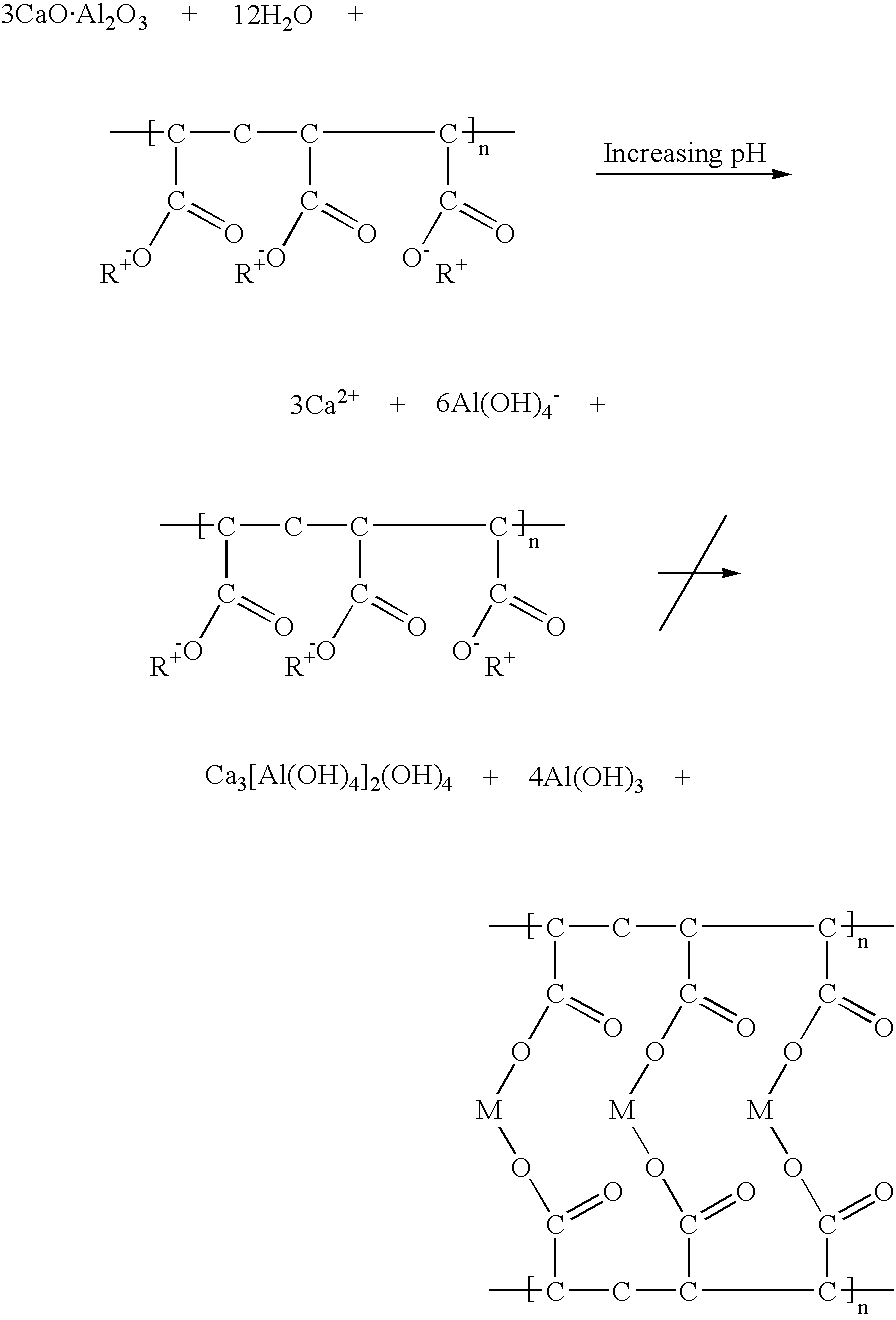Two-Step System For Improved Initial And Final Characteristics Of A Biomaterial
a biomaterial and initial and final characteristic technology, applied in the field of two-step system for improving the initial and final characteristics of a biomaterial, can solve problems such as tooth cracking in weakened teeth, and achieve the effect of high performance end features
- Summary
- Abstract
- Description
- Claims
- Application Information
AI Technical Summary
Benefits of technology
Problems solved by technology
Method used
Image
Examples
example 1
[0043]Tests were performed to investigate the influence of amount of poly acid and the composition of the chemical bonded ceramic on the mechanical properties. The values are compared to commercial glass ionomer cement and amalgam.
Raw Materials Used
[0044]Calcium aluminate ((CaO)3(Al2O3), (CaO)(Al2O3), (CaO)12(Al2O3)7), calcium silicates (CaO)(SiO2, (2CaO)(SiO2), (3CaO)(SiO2), dental glass filler (Schott), poly acid (PAA=poly acrylic acid Mw=50,000, Na-PAMA=poly(acrylic-co-maleic acid) sodium salt Mw=50,000) and reactive glasses (Schott and experimental glass). Glass ionomer cement (Fuji II, GC-corp) and Amalgam (Dispersalloy, Dentsply).
Preparation of Material Used
[0045]Calcium aluminate was mixed with dental glass, reactive glass, poly acrylic acid and poly(acrylic-co-maleic acid) sodium salt. The calcium aluminate phases were synthesised via a sintering process, wherein first CaO and Al2O3 were mixed to the desired composition and then sintered at elevated temperature for 6 hours. ...
example 2
[0049]A series of tests was performed to investigate the influence of poly acid on the acid erosion resistance. The values are compared to commercial glass ionomer cement (Fuji II) and to commercial calcium aluminate based dental material (DoxaDent, Doxa AB).
Raw Materials Used
[0050]Calcium aluminate (CaO)(Al2O3), dental glass filler (Schott), Na-PAMA=poly(acrylic-co-maleic acid) sodium salt, poly acrylic acid Mw 50000, reactive glass.
Description of Tests
[0051]Test a) to c) investigated:[0052]a) the acid erosion of Fuji II[0053]b) the acid erosion of DoxaDent[0054]c) as formulation 3 described in Example 1.[0055]d) as formulation 7 described in Example 1.
[0056]The calcium aluminate phases were synthesised via a sintering process where first CaO and Al2O3 were mixed to the desired composition and then sintered at elevated temperature for 6 hours. The formed calcium aluminate lumps were crushed and jet-milled to a mean grain size of 3 μm and a maximum grain size of 9 μm. The dental gla...
example 3
[0058]A series of tests was performed to investigate the possible in vitro bioactivity of the calcium based cement material, the glass ionomer cement and the combination of the two. Bioactivity is defined herein as the ability to form apatite on the surface in contact with body fluids.
Preparation of Materials Used
[0059]Calcium aluminate was mixed with dental glass, reactive glass, poly acrylic acid and poly(acrylic-co-maleic acid) sodium salt. The calcium aluminate phases were synthesised via a sintering process where first CaO and Al2O3 was mixed to the desired composition and then sintered at elevated temperature for 6 hours. The formed calcium aluminate lumps were crushed and jet-milled to a mean grain size of 2.5 μm and a maximum grain size of 9 μm. The dental glass, calcium aluminate and poly acids were mixed with acetone and Si3N4 marbles for 14 hours to obtain the desired homogeneity. The same procedure was used for the Formulation 8 using Ca silicates. Formulations were made...
PUM
| Property | Measurement | Unit |
|---|---|---|
| Fraction | aaaaa | aaaaa |
| Fraction | aaaaa | aaaaa |
| Fraction | aaaaa | aaaaa |
Abstract
Description
Claims
Application Information
 Login to View More
Login to View More - R&D
- Intellectual Property
- Life Sciences
- Materials
- Tech Scout
- Unparalleled Data Quality
- Higher Quality Content
- 60% Fewer Hallucinations
Browse by: Latest US Patents, China's latest patents, Technical Efficacy Thesaurus, Application Domain, Technology Topic, Popular Technical Reports.
© 2025 PatSnap. All rights reserved.Legal|Privacy policy|Modern Slavery Act Transparency Statement|Sitemap|About US| Contact US: help@patsnap.com



